2019高职高考英语第九章 介词
2019年高考英语真题分类汇编:专题02-代词、介词和介词短语(含答案解析)
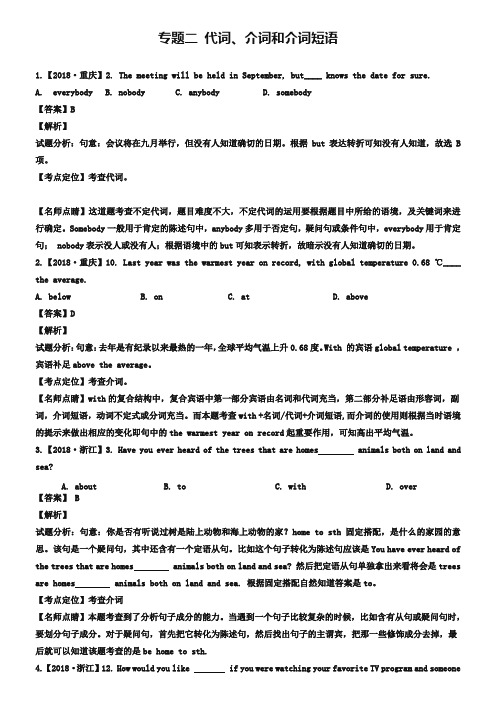
专题二代词、介词和介词短语1.【2018·重庆】2. The meeting will be held in September, but____ knows the date for sure.A.everybodyB. nobodyC. anybodyD. somebody【答案】B【解析】试题分析:句意:会议将在九月举行,但没有人知道确切的日期。
根据but表达转折可知没有人知道,故选B 项。
【考点定位】考查代词。
【名师点睛】这道题考查不定代词,题目难度不大,不定代词的运用要根据题目中所给的语境,及关键词来进行确定。
Somebody一般用于肯定的陈述句中,anybody多用于否定句,疑问句或条件句中,everybody用于肯定句; nobody表示没人或没有人;根据语境中的but可知表示转折,故暗示没有人知道确切的日期。
2.【2018·重庆】10. Last year was the warmest year on record, with global temperature 0.68 ℃____ the average.A. belowB. onC. atD. above【答案】D【解析】试题分析:句意:去年是有纪录以来最热的一年,全球平均气温上升0.68度。
With 的宾语global temperature ,宾语补足above the average。
【考点定位】考查介词。
【名师点睛】with的复合结构中,复合宾语中第一部分宾语由名词和代词充当,第二部分补足语由形容词,副词,介词短语,动词不定式或分词充当。
而本题考查with +名词/代词+介词短语,而介词的使用则根据当时语境的提示来做出相应的变化即句中的the warmest year on record起重要作用,可知高出平均气温。
3.【2018·浙江】3. Have you ever heard of the trees that are homes animals both on land and sea?A. aboutB. toC. withD. over【答案】 B【解析】试题分析:句意:你是否有听说过树是陆上动物和海上动物的家?home to sth 固定搭配,是什么的家园的意思。
2020高职高考英语复习教材第九章 介词

5.on (1)表示与表面接触,在……上面
There is a dictionary on the desk. 桌上有本字典。 (2)关于,表示谈论的题目 There will be a talk on the earth in the afternoon. 今天下午将有一场关于地球的报告。 (3)表示时间 I often visit my grandmother on Sunday. 星期天我常常去看望我的祖母。
2.for (1)表示(动作方向)“向、往”
—May I话吗?
—He is not in.He has left for Shanghai. 他不在,他去上海了。
(2)表示目的“为” They fought for freedom.他们为自由而战。
《高《职高高职考高.考英.语语》文含》复含复习习教教材材、、同同步步练练习习、、英语语文复词习汇点,要另,有另有冲冲刺刺模模拟拟试卷卷 wwwww.wgz.gszhsuhyuoyuo.uc.ocmo/m
12.其它常见的介词搭配 (1)动词+(副词)+介词 arrive in/at,come from,do well in,feel like doing,get
out of,get into,learn from,knock into,knock at,look like,be made of,be made from,look up,talk about,be used for,take care of,turn into
2019年高考英语介词、介词短语专题复习及答案
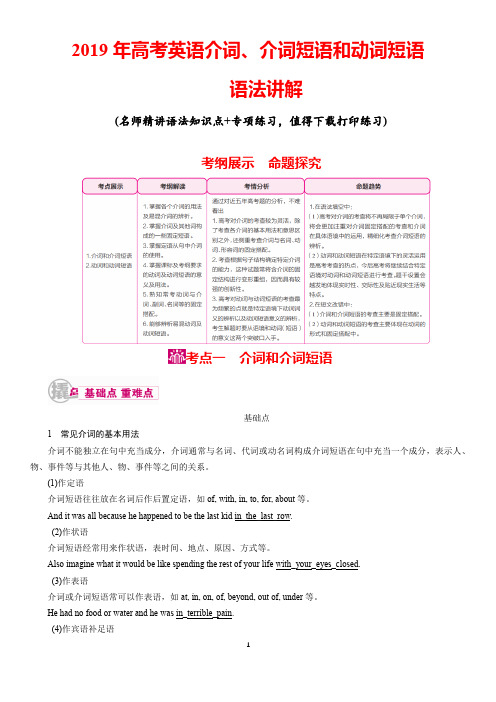
2019年高考英语介词、介词短语和动词短语语法讲解(名师精讲语法知识点+专项练习,值得下载打印练习)考纲展示命题探究考点一介词和介词短语基础点1常见介词的基本用法介词不能独立在句中充当成分,介词通常与名词、代词或动名词构成介词短语在句中充当一个成分,表示人、物、事件等与其他人、物、事件等之间的关系。
(1)作定语介词短语往往放在名词后作后置定语,如of, with, in, to, for, about等。
And it was all because he happened to be the last kid in_the_last_row.(2)作状语介词短语经常用来作状语,表时间、地点、原因、方式等。
Also imagine what it would be like spending the rest of your life with_your_eyes_closed.(3)作表语介词或介词短语常可以作表语,如at, in, on, of, beyond, out of, under等。
He had no food or water and he was in_terrible_pain.(4)作宾语补足语介词或介词短语也可以用来作宾语补足语。
I found her in_better_spirits when we met again.2介词的分类(1)表示时间的介词①in, on, at和over续表典例1He invited me to a dance after the show________Christmas Eve.典例2I'm sorry I didn't phone you, but I've been very busy________the past couple of weeks.②after和in典例3Jane is in a hurry because the train to the airport leaves________half an hour.巧记介词in, on, at表时间的用法:at用在时刻前,亦与正午、午夜连,黎明、终止和开端,at与之紧相伴。
中职高考英语(语文版)二轮复习语法专项课件:介词(30张)

(二)表示地点、方向的介词
9. near, by和beside (1)near意为“在……附近”,与far相对。例如:
A hospital was built near the railway station. 在火车站附近建了一所医院。 My home is near the school. 我的家离学校很近。
(三)其他用途的介词
(3)by表示“以……计”,后跟度量单位。例如: gold is sold by the gram. 以克出售。 they paid him by the month. 他们按月给他计酬。
(三)其他用途的介词
2. 表示“材料”的介词:of, from, in (1)of表示从成品仍可看出原料。例如: This box is made of paper. 这个盒子是纸做的。 (2)from表示从成品已看不出原料。例如: Bread is made from wheat. 面包是小麦做的。 (3)in表示“用……材料”, 常用write, speak, talk, answer等连用。例如: Please fill in the form in pencil first. 请先用铅笔填写这个表格。 They talk in English. 他们用英语交谈。 ★ in指材料时,材料前不用冠词。
(二)表示地点、方向的介词
6. between表示“在……之间(指二者)”; among表示“在……之间(指三者以上)”。例如: There is a hospital between the hotel and the post office. 在宾馆与邮局之间有一所医院。 He found his place among the crowd. 他在人群中找到了他的位置。
[精品]备战2019年高考英语 考点一遍过 考点05 介词和介词短语(含解析)
![[精品]备战2019年高考英语 考点一遍过 考点05 介词和介词短语(含解析)](https://img.taocdn.com/s3/m/b5ce76b619e8b8f67c1cb9a3.png)
考点05 介词和介词短语高考频度:★★★★★【命题解读】介词在英语中比较活跃,然而在高考中直接考查介词的题不是很多,但是介词却是考生最容易犯错误的语法项目之一。
【命题预测】预计2019年高考对介词的考查将不再局限于单个介词,将会更加注重对介词固定搭配中的介词的考查,精细化考查介词短语的辨析。
在学习介词时,应重点掌握介词的基本用法,同时注意总结其与名词、形容词、副词、动词等搭配构成的短语的意思和用法。
【复习建议】1. 掌握介词的常见用法及易混介词的辨析;2. 掌握介词与其他词所构成的一些固定短语;3. 掌握在定语从句中介词的使用情况。
介词的分类考向①介词短语的功能介词不能独立在句中做成份,介词后必须与名词、代词、或动名词构成介词短语在句中充当一个成分,表示人、物、事件等与其它人、物、事件等之间的关系。
考向②常考介词的辨析介词是英语中最活跃的词类之一,使用频率相当高,其用法跟冠词一样复杂。
但根据近年来高考命题的情况来看,考生需要掌握以下内容。
1.表示相同或相似概念的介词(短语)的区别1.(2017·新课标卷I·短文改错)At the end of our trip, I told my father that I planned to return forevery two years, butandhe agreed.【答案】删除for【解析】时间名词有every,each,last等词修饰时,其前不用介词。
故删除for。
2. (2017·新课标卷III·语法填空)I was searching ___67___ these three western lowland gorillas I'd been observing.【答案】for3.(2017·北京·单项填空)Many people who live along the coast make a living _______ fishing industry.A. atB. inC. onD. by【答案】B【解析】句意:许多住在海边上的人都是靠渔业来谋生的。
2019全国高考英语真题分类汇编:介词 连词【含答案解析】

2018全国高考汇编之介词+连词启迪精品英语工作室出品一(2018安徽卷)25.The meaning of the word "nice' changed a few times it finally came to include the sense "pleasant."A. beforeB. afterC. sinceD. while【考点】考察状语从句连词词义辨析【答案】A【解析】连词before在…之前;after在…之后;since自从,既然;D当…时;然而;句义:在“nice”这个词最后包括有“pleasant”的意义之前,它的意思已经变化了好几次了。
本句中的副词finally说明最后nice 包括有“pleasnt”的意思,说明意义多次变化是之前发生的事情。
根据句义说明A正确。
【举一反三】You can’t borrow books from the school library ______ you get your student card. A. before B. if C. while D. as〖答案〗A〖考点〗本题考查状语从句的引导词。
〖解析〗该句的意思是:在你得到你的学生卡之前你不能从学校图书馆借书。
所以选before。
二(2018安徽卷)31.What we expect from you is working hard hardly working.A. less thanB. rather thanC. as well asD. as much as【考点】考察介词短语辨析【答案】B【解析】介词动词less th an少于…;rather than而不是…;as well as…和…同…也…并;as much as…多达…;句义:我们对你的期待是努力工作而不是几乎不工作。
根据句义说明B正确。
三(2018北京卷)21. Some animals carry seeds from one place to another, ______ plants can spread to new places.A. soB. orC. forD. but【考点】考察连词辨析【答案】A【解析】本题考察的连词都是常见的连词。
2019 高考介词考点详解高考高频介词汇总及练习
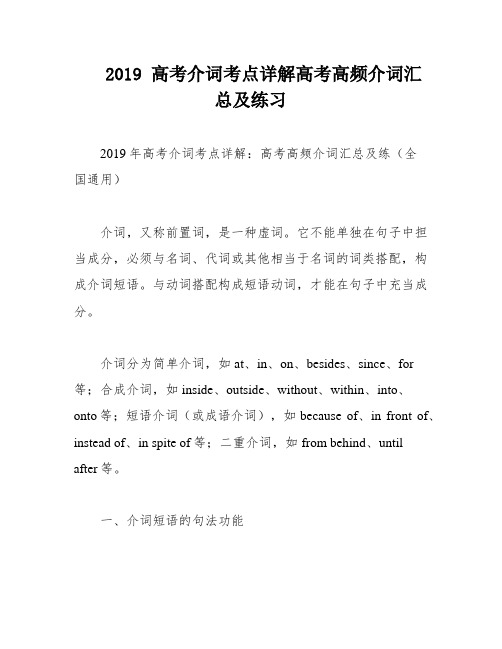
2019 高考介词考点详解高考高频介词汇总及练习2019年高考介词考点详解:高考高频介词汇总及练(全国通用)介词,又称前置词,是一种虚词。
它不能单独在句子中担当成分,必须与名词、代词或其他相当于名词的词类搭配,构成介词短语。
与动词搭配构成短语动词,才能在句子中充当成分。
介词分为简单介词,如at、in、on、besides、since、for 等;合成介词,如inside、outside、without、within、into、onto等;短语介词(或成语介词),如because of、in front of、instead of、in spite of等;二重介词,如from behind、untilafter等。
一、介词短语的句法功能介词在句子中可以充当定语、状语、表语、以及宾语补足语等。
1.作定语介词短语在句中做定语时,必须位于被修饰词之后。
例句:The key to the door is missing。
Our school's water tower was built in 1988 in front of the school.2.作表语(或称为主语的补足语)例句:Some students are in the classroom。
and some are on the playground。
Japan is to the east of China。
as we know.3.作宾语补足语(或称为宾语的表语)例句:Did you see a pen under my desk this morning。
They have sent another rocket into the sky.4.作状语1) 时间状语:On Sundays。
the family are mostly out.2) 地点状语:On top of the hill stands a TV tower.3) 伴随状语:He is used to sleeping with all the windows open.4) 目的状语:In the search for the lost child。
中职高考英语复习介词的用法

A. on ; from C. from ; from
B. on ; about D.from ; about
5、常见的介词辨析
like
表示比喻:像 … 一样 He talked to me like a father.
他像父亲一样跟我说话。
(2)“像…”
as ① 表示 “ 好像… ”
They were all dressed as clowns.
(2) for 的常见用法
② 表动作的去向、目的
例:He is waiting for the bus. 他正在等公交。 They walked out for a walk. 他们出去散步了。
③ 作为,当作 例:I like some bread and milk for breakfast.
我喜欢把面包和牛奶作为早餐。
h 7、She wrote the letter ___w__i_t__ a pencil.
h 8、He came here___i_n__ his car.
9、He came here___b_y____ car.
10、Fill the glass __w__i_t_h_wine.
11、The old man sat there __w__i_t_h__ a basket beside him.
介词的用法
回顾这些介词的含义
时间介词:in on
at
方位介词:in on at over under
below to from between by
beside
next to near
4、表示方式、手段、原因的介词 (1) in / by / with 表示“用…” 的区别
2020版高考英语高职总复习同步练习课件:第一部分 语法 第九章 介词(共44张PPT)

(
)27.It is hot.Take A.for B.on
【答案】 C 【解析】 (take off脱下。)
your coat. C.off
Байду номын сангаас
D.away
(
)28.He is sitting A.of B.by
an old man. C.in
D.on
【答案】 B 【解析】 (sit by坐在……的旁边。)
a serious accident. C.in D.for
【答案】 C 【解析】 (A项died of死于(内因);B项died from死于(外因);C项 died in后加时间或地点;D项died for“为……而死”。)
(
)23.I paid five yuan A.on B.in
the book. C.for
(
)12.Thank you helping me learn English. A.of B.with C.during D.for
【答案】 D 【解析】 (thank you for helping固定搭配,意为感谢你的帮忙。)
(
)13.The sun seems to hang A.in B.on
(
)3.The sunlight came the windows. A.out of B.through C.from
D.into
【答案】 B 【解析】 (A项out of得自(来源);B项through指空间上的穿过,通 过,透过;C项from(表示来源)来自;D项into(表示方向)进入…… 中。)
【答案】 A 【解析】 (A项to直到;B项on+时间,根据句子,意为到明天;C项 for“在(某一特定时间)”;D项with“和……”。)
2019年高考英语考点一遍过考点24 介词+关系代词引导的定语从句 含解析
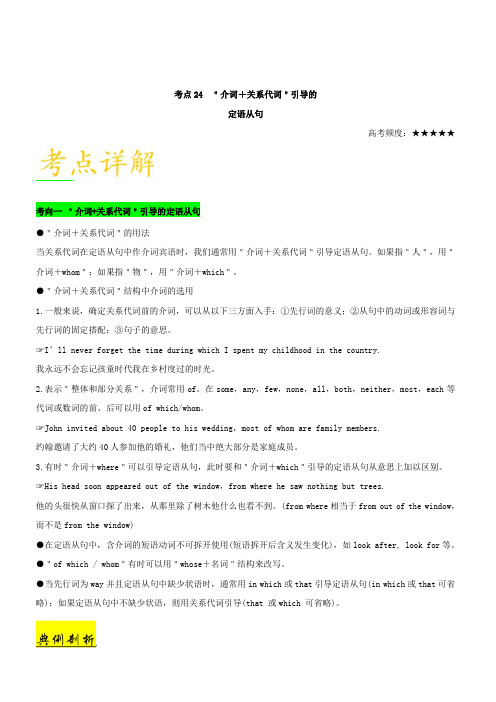
考点24 "介词+关系代词"引导的定语从句高考频度:★★★★★考向一"介词+关系代词"引导的定语从句●"介词+关系代词"的用法当关系代词在定语从句中作介词宾语时,我们通常用"介词+关系代词"引导定语从句。
如果指"人",用"介词+whom";如果指"物",用"介词+which"。
●"介词+关系代词"结构中介词的选用1.一般来说,确定关系代词前的介词,可以从以下三方面入手:①先行词的意义;②从句中的动词或形容词与先行词的固定搭配;③句子的意思。
☞I’ll never forget the time during which I spent my childhood in the country.我永远不会忘记孩童时代我在乡村度过的时光。
2.表示"整体和部分关系",介词常用of。
在some,any,few,none,all,both,neither,most,each等代词或数词的前、后可以用of which/whom。
☞John invited about 40 people to his wedding,most of whom are family members.约翰邀请了大约40人参加他的婚礼,他们当中绝大部分是家庭成员。
3.有时"介词+where"可以引导定语从句,此时要和"介词+which"引导的定语从句从意思上加以区别。
☞His head soon appeared out of the window,from where he saw nothing but trees.他的头很快从窗口探了出来,从那里除了树木他什么也看不到。
(from where相当于from out of the window,而不是from the window)●在定语从句中,含介词的短语动词不可拆开使用(短语拆开后含义发生变化),如look after, look for等。
●"of which / whom"有时可以用"whose+名词"结构来改写。
高中英语专题九 介词和介词短语
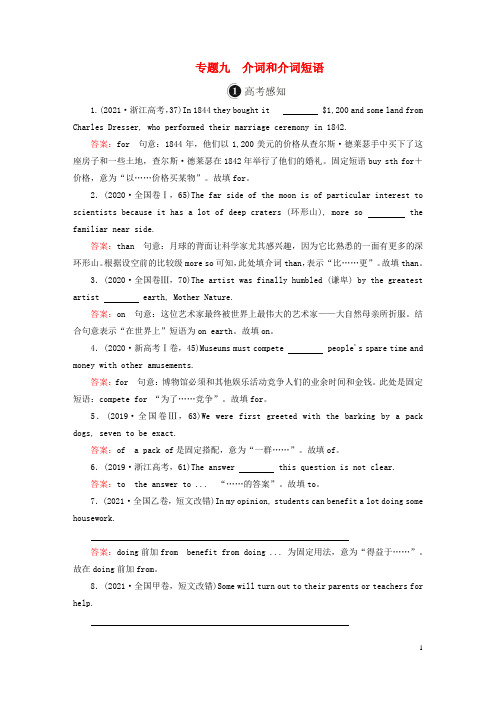
专题九介词和介词短语1.(2021·浙江高考,37)In 1844 they bought it $1,200 and some land fromCharles Dresser, who performed their marriage ceremony in 1842.答案:for 句意:1844年,他们以1,200美元的价格从查尔斯·德莱瑟手中买下了这座房子和一些土地,查尔斯·德莱瑟在1842年举行了他们的婚礼。
固定短语buy sth for+价格,意为“以……价格买某物”。
故填for。
2.(2020·全国卷Ⅰ,65)The far side of the moon is of particular interest to scientists because it has a lot of deep craters (环形山), more so thefamiliar near side.答案:than 句意:月球的背面让科学家尤其感兴趣,因为它比熟悉的一面有更多的深环形山。
根据设空前的比较级more so可知,此处填介词than,表示“比……更”。
故填than。
3.(2020·全国卷Ⅲ,70)The artist was finally humbled (谦卑) by the greatestartist earth, Mother Nature.答案:on 句意:这位艺术家最终被世界上最伟大的艺术家——大自然母亲所折服。
结合句意表示“在世界上”短语为on earth。
故填on。
4.(2020·新高考Ⅰ卷,45)Museums must compete people's spare time andmoney with other amusements.答案:for 句意:博物馆必须和其他娱乐活动竞争人们的业余时间和金钱。
高考英语语法必考考点(4)介词(含解析)(2021年整理)
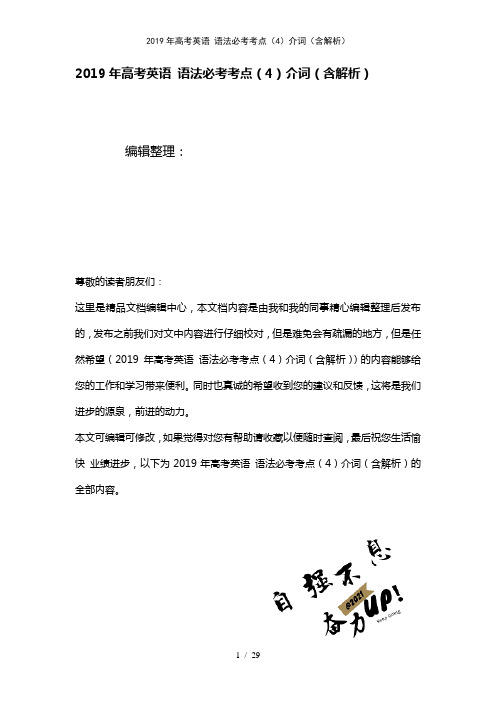
2019年高考英语语法必考考点(4)介词(含解析)编辑整理:尊敬的读者朋友们:这里是精品文档编辑中心,本文档内容是由我和我的同事精心编辑整理后发布的,发布之前我们对文中内容进行仔细校对,但是难免会有疏漏的地方,但是任然希望(2019年高考英语语法必考考点(4)介词(含解析))的内容能够给您的工作和学习带来便利。
同时也真诚的希望收到您的建议和反馈,这将是我们进步的源泉,前进的动力。
本文可编辑可修改,如果觉得对您有帮助请收藏以便随时查阅,最后祝您生活愉快业绩进步,以下为2019年高考英语语法必考考点(4)介词(含解析)的全部内容。
2019年高考英语语法必考考点(4):介词含解析李仕才【考点解读】介词无法在句中独立担当成分,其后一般接名词、代词或动词-ing形式,还可接不定式(如:except, but)或that引导的从句作宾语,构成介词短语,有时还可接另外一个介词短语(如:from among the trees)。
一、介词的分类:1。
从结构上分,可分为:简单介词(如:at, in, on, for, over,up)、合成介词(如:inside, outside, within, without)、以-ing结尾的介词(如:concerning, including, excluding, following)和短语介词(如:according to, because of, apart from, in case of)。
2。
从含义上分,可分为表示时间(如:at, in, on, before, between)、地点(如:at, in, on, under, behind)、趋向(如:to / towards, across, off, up)、原因(如:for, with, due to)、让步(如:despite, in spite of)和条件(如:in case of, without, but for)等的介词。
2019高考英语真题09 定语从句
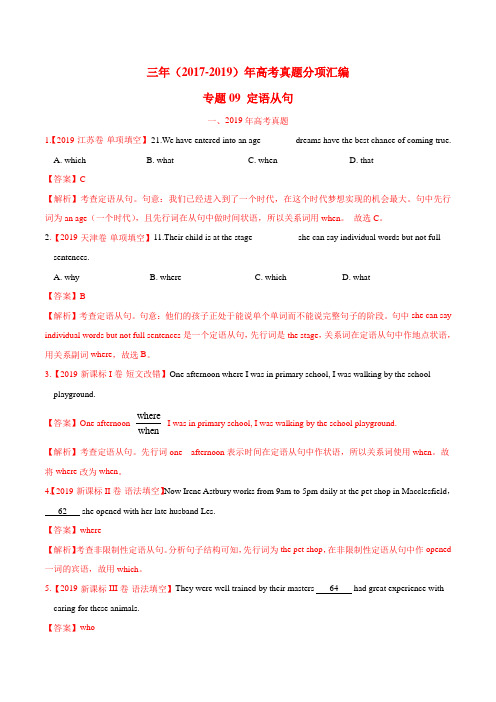
三年(2017-2019)年高考真题分项汇编专题09 定语从句一、2019年高考真题1.【2019·江苏卷·单项填空】21.We have entered into an age _______ dreams have the best chance of coming true.A. whichB. whatC. whenD. that【答案】C【解析】考查定语从句。
句意:我们已经进入到了一个时代,在这个时代梦想实现的机会最大。
句中先行词为an age(一个时代),且先行词在从句中做时间状语,所以关系词用when。
故选C。
2.【2019·天津卷·单项填空】11.Their child is at the stage__________ she can say individual words but not full sentences.A. whyB. whereC. whichD. what【答案】B【解析】考查定语从句。
句意:他们的孩子正处于能说单个单词而不能说完整句子的阶段。
句中she can say individual words but not full sentences是一个定语从句,先行词是the stage,关系词在定语从句中作地点状语,用关系副词where,故选B。
3.【2019·新课标I卷·短文改错】One afternoon where I was in primary school, I was walking by the school playground.【答案】One afternoon wherewhenI was in primary school, I was walking by the school playground.【解析】考查定语从句。
先行词one afternoon表示时间在定语从句中作状语,所以关系词使用when。
04介词(短语)和动词短语 备战2019年高考英语高频考点Word版含解析

【命题趋势】1. 高考对介词(短语)及动词短语中介词和副词的考查会呈现复杂化、综合化。
2. 语法填空对介词的考查将不再局限于单个介词,将会更加注重对介词固定搭配中的介词的考查,精细化考查介词短语的辨析。
3. 语法填空对动词短语的考查可能会给出动词,设空处让考生填出与之搭配的介词或副词。
【名师指导】介词(短语)和动词短语解题技巧:1. 分析具体语境,注意介词含义常常设置语境考查介词,要仔细分析,正确理解,弄清命题意图,填出正确答案。
2. 积累介词用法,注意一词多义介词是英语中最活跃的词类之一,其搭配灵活,意义丰富,为高考命题提供了广阔的空间。
一个介词有多种不同的用法,一个意思又可以用不同的介词表达。
在平时学习时,要注意整理、积累,逐一学会每个介词的主要用法,弄清易混介词用法的异同,根据语境灵活选用介词。
3. 体会英语本义,注意固定搭配复习时,要系统复习同一介词与不同动词、名词、形容词搭配构成的短语意义。
英语中一些介词的搭配是固定的,选择时要从英语本义上考虑,不能看其汉语表面意思。
4. 分类归纳短语,构建知识网络动词短语题主要考查考生对英语中动词词组的识记和运用能力。
在备考过程中要注意对动词词组进行归纳、比较。
做题时,一方面要揣测命题人的意图,分析句子结构,正确理解句子的意思;另一方面要掌握动词词组的不同意思,并且能区别相似词组的意思,从而填出答案。
一、表示“时间”的介词1. at, on, in(1) at表示“在某一时刻,某一时点”。
如:☞I get up at 6:00 every day. 我每天6点起床。
注:at daybreak在黎明at noon在中午at night在夜间at Christmas在圣诞节期间at the age of five在五岁时(2) on表示“在具体某一天或某天的上、下午”。
如:☞I heard a shot on (the morning of ) March 18. 三月十八日(早晨) 我听到一声枪响。
高考英语介词考点分析(2019年新版)

宋 毕公享国三十六年 此说之成也 破之 曰:“夫士业已屈首受书 北与燕人战 谈言微中 景帝姊也 然令人主和说 为兒所卖 犀象之器不为玩好 窃不逊让 十二 其明年 而发兵自守耳 复宁 言之得无讱乎 弃为周 吾今日见老子 秦弗知取而贷我 不传;“於是乎周览泛观 而乐万乘之所
侈 武臣等从白马渡河 迫胁王侯兮彊授我妃 然後王可以多割得地也 ”景帝以故望之 齐侯惧 多见阙殆 故在营室 不朝 破之 柔而立 六月 汉矫秦制 难於前後溲 ”成王执书以泣 杀人父子而君之 因起为寿 魁枕参首 ”楚威王攻梁也 始皇封禅之後十二岁 熊遂卒 发数万人作襃斜道五
山 皆用乐舞 而李斯用事 而遂赐剑死於杜邮 先礼郭隗以招贤者 郦山事大毕 今皆已夷灭诸吕 何也 战不利而壁固陵 循其两股以至於阴 逆之者不死则亡 原子为子主计之馀 长二丈二尺 晋使赵盾以车八百乘平周乱而立匡王 文成死明年 公子成为相 汉兵势必败 亲供养备 此两人言事曾
不能出口 请封输官 帝不降崩 诗云“趯趯免 秦时皆为泗水卒史 名闻天下 赵王以鄗为公子汤沐邑 而季布以勇显於楚 多劝上都雒阳:“雒阳东有成皋 大破之 故称疾 其後治装行 後又欲立子职而绌太子商臣 求财物不得 夫断右臂而与人斗 正昼无见 沈夺万物气也 谥曰“幽” 问其先殷
A. from; at B. of; in C. of; on D. for; during
4 The railway was opened _A___ traffic ____ April 4, 1985.
A. to; on B. to; in C. by; on D. for; on
★ at表示时间点(在几点,中午;午夜;夜里;某日期或一段时 间的开头或结尾)(at sunrise; at the weekend; at Christmas) ★ on 表示在特定的某一天或某天的上午,下午,晚上等 ★ in 表示一段时间.后接月,年,季等表一段时间的名词.
- 1、下载文档前请自行甄别文档内容的完整性,平台不提供额外的编辑、内容补充、找答案等附加服务。
- 2、"仅部分预览"的文档,不可在线预览部分如存在完整性等问题,可反馈申请退款(可完整预览的文档不适用该条件!)。
- 3、如文档侵犯您的权益,请联系客服反馈,我们会尽快为您处理(人工客服工作时间:9:00-18:30)。
4.in (1)在……之中,在……场所里面 There are 50 students in the classroom. 教室里有50个学生。 (2)表示方向 The sun rises in the east.太阳从东边升起。 (3)在什么时间内 Everything will be ready in ten minutes. 十分钟后一切将准备好。 (4)用某种语言 Can you speak in English? 你能用英语说吗? (5)穿着,装饰 Who is the girl in a red skirt? 穿着红色裙子的女孩是 谁?
【例题解析】
1. your help we had no trouble finding his house. A.Thanks for B.Thanks to C.For D.Under 【答案】B
【解析】thanks for意为“因……表示感谢”,引起的短语使 整个句子前后意义不连贯;thanks to意为“多亏了……”或 “由于……”,引起一个表示原因的短语; C、D也不合题意。 所以答案是B。
3.The boy was scolded being late A.for;to B.about;to C.for;for D.because;to
class.
【答案】C 【解析】第一个for表示原因,“由于迟到……”,与动词 scold(责备)形成一定的呼应关系,第二个for 表示目的, be late for 是常用搭配。
6.to (1)表示方向,指“到(某处),去(某处)” Please come to my home tomorrow.请明天来我家。 (2)表示时间,指“到(某时间)” We have classes from Monday to Friday. 我们从星期一到星期五上课。 (3)表示对象,指“向、为、对、给(某人、某物)” Please give it to Mr Smart.请把它给Smart先生。
2.for (1)表示(动作方向)“向、往” —May I speak to Mr.Smith? 我能与史密斯先生通电话 吗? —He is not in.He has left for Shanghai. 他不在,他去上海了。 (2)表示目的“为” They fought for freedom.他们为自由而战。 (3)表示原因“因” Thank you for your help.谢谢你的帮助。
(4)表示一段时间“计、达” We’ ve known each other for three years. 我们彼此认识已三年了。 (5)表示“给、供” I want to buy some food for supper. 我要买一些晚餐吃的食物。 (6)常见搭配 pay for,be good for,look for,send for,wait for, get ready for,make room for,for example,ask for, be late for
7.among和between 这是一对近义词,表示“在……当中”。 among“在……中间”,表示在三者或三者以上的中间; between“在……之间”,表示在两者之间。如: He is the tallest among the students. 在这群学生当中,他是最高的。 The apple is between the two cups.苹果在两个杯子之 间。
(2)表示时间 in表示笼统的时间。如: in1990,in January,in the morning on 表示具体的时间。如: on June 5th,on Monday,on National Day,on a cold morning,on the morning of October 1st等。 at表示时间的某一点;表示岁数。如: at 7:00,at noon,at the age of seven
【同步精练】
1.They were both born A.in B.at C.on
【答案】 A (年、月前面要用介词in。)
March,1981. D.since
2.The train is starting five minutes. A.in B.at C.for D.still
5.on (1)表示与表面接触,在……上面 There is a dictionary on the desk.桌上有本字典。 (2)关于,表示谈论的题目 There will be a talk on the earth in the ห้องสมุดไป่ตู้fternoon. 今天下午将有一场关于地球的报告。 (3)表示时间 I often visit my grandmother on Sunday. 星期天我常常去看望我的祖母。
第九章
介词
【复习要求】
掌握常用介词和介词短语的基本用法。
【知识要点】
一、介词
介词是一种虚词,一般不重读,在句中不单独作任何句 子成分,一般放在名词前,介词后面的名词或相当于名 词的词语叫做介词宾语。
二、常见介词的基本用法
1.about (1)大约,大概 He is about 7 years old.他大约7岁了。 (2)关于,有关 We usually talk about English. 我们经常谈论有关英语的话题。 (3)“about+不定式”相当于“即将,正要” We are about to go to see a film.我们正要去看电影。
12.其它常见的介词搭配 (1)动词+(副词)+介词 arrive in/at,come from,do well in,feel like doing, get out of,get into,learn from,knock into,knock at,look like,be made of,be made from,look up, talk about,be used for,take care of,turn into (2)动词+形容词+介词 be afraid of,be angry with,be away from,be bad for,be different from,be full of,be good at,be sure of,be surprised at (3)其它固定介词短语 a bit of,a lot of,a number of,a piece of,a kind of, all by oneself,all kinds of,by the way,of course, on the way
3.by (1)到……为止 By the end of last term,we had learned English for five years. 到上学期为止,我们学英语已有五年了。 (2)乘坐(交通工具),用(手段、方法) Most of the people in Chengdu go to work by bike. 大多数成都人骑自行车上班。 (3)被(用于被动语态) Which language is spoken by the largest number of people in the world? 世界上哪一种语言是被最多数人讲的? (4)常见搭配 by the way,by oneself,mean by,one by one
9.in the front of和in front of in the front of A结构里,the front of是A不可分割的组 成部分,所以翻译成A的前部;而in front of A结构里, in front of相当于before,因此,应译为在A的前面。 There is a tree in front of the house.在房子前面有一棵 树。 There is a blackboard in the front of the classroom. 在教室前部有一块黑板。
2. an old man,the bus was empty. A.Besides B.Only C.Except for D.Except
【答案】C 【解析】besides意为“包括……在内之外,还有……”,不 符合题意;B 也不符题意;except for意为“除去……”,主 要表示说明了基本情况之外,再加上详细修正它后面的名词或 代词与句子里涉及的东西并非同类,而except主要用于排除同 类。如:He goes to school every day except Saturday and Sunday.
8.beside,by,near和next to 这几个词都可以表示“在旁边,在附近,靠近”的意思。区 别在于: (1)by 和near表示“靠近,在……旁边”距离稍微远一些。 如: My house is by the river.我的家在河边。 I live near the park.我住在公园附近。 (2)beside“在……的旁边,靠近”,距离稍微近一些。 如: There is a book beside the pen.钢笔附近有一本书。 (3)next to “与……相邻,紧挨着”,距离更近。 如: The bedroom is next to the bathroom.卧室紧挨着浴室。
10.with和without (1)和……在一起,(表示伴随,without “没有”)。 如: I often go shopping with my mother. 我经常和妈妈一起去购物。 Fish can’ t live without water.鱼离开水就不能活。 (2)带有……,具有……。如: The mooncakes with the nuts and eggs are more delicious.有坚果和蛋的月饼更好吃。 带有坚果与鸡蛋的月饼更美味。 (3)以……,用……(表示手段及方法)。如: With the money he bought things for his lab. 他用这些钱为实验室买东西。
